Abstract
The Fts proteins play an important role in the control of cell division in Escherichia coli. These proteins, which possibly form a functional complex, are encoded by genes that form an operon. In this study, we examined the properties of the temperature-sensitive mutation ftsZ84 harbored by low- or high-copy-number plasmids. Cells of strain AB1157, which had the ftsZ84 mutation, did not form colonies on salt-free L agar at 30 degrees C. When a low-copy-number plasmid containing the ftsZ84 mutation was present in these mutant cells, colony formation was restored on this medium at 30 degrees C, suggesting that FtsZ84 is probably less active than the wild-type protein and is therefore limiting in its capacity to trigger cell divisions. On the other hand, when the ftsZ84 mutation was harbored by the high-copy-number plasmid pBR325, colony formation was prevented on salt-free L agar plates whether the recipients were ftsZ84 mutant or parental cells, suggesting that, at high levels, FtsZ84 acts as a division inhibitor. The fact that colony formation was also prevented at 42 degrees C indicates that the FtsZ84 protein is not inactivated at the nonpermissive temperature. The possibility that FtsZ84 is a more efficient division inhibitor than the wild-type FtsZ is discussed. Evidence is also presented showing that a gene adjacent to mutT codes for a product that, under certain conditions, suppresses the ftsZ84 mutation.
Full text
PDF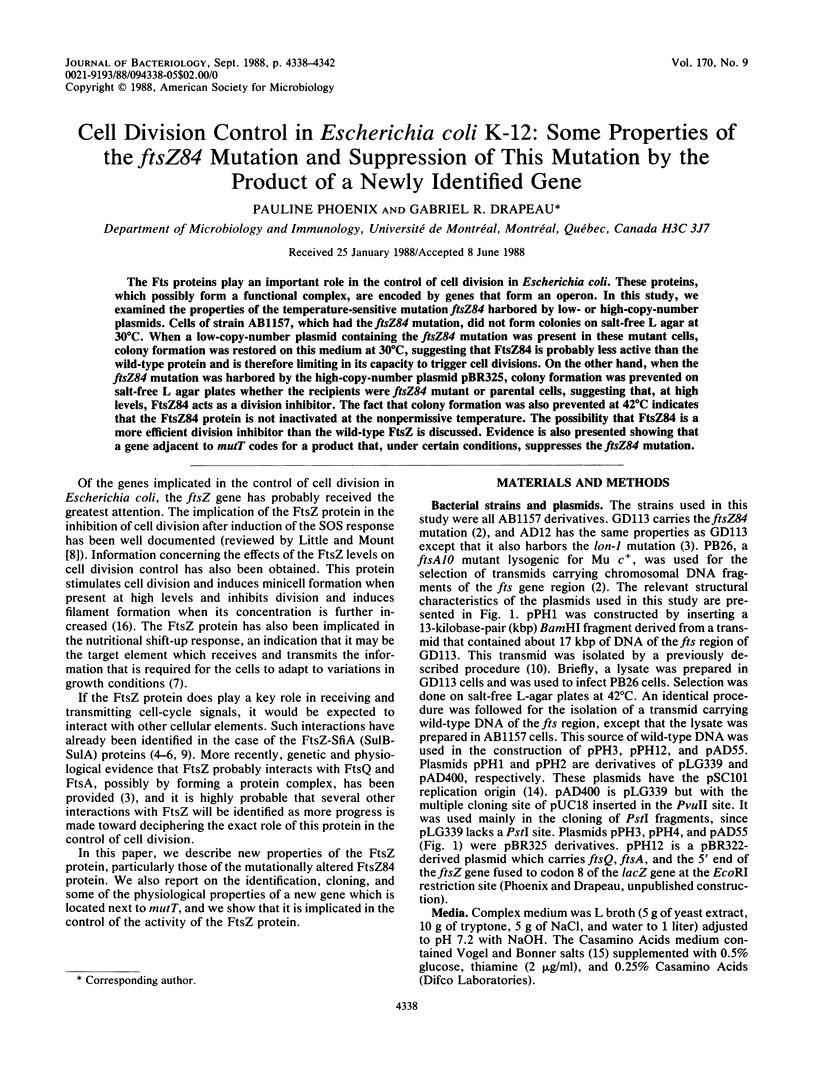
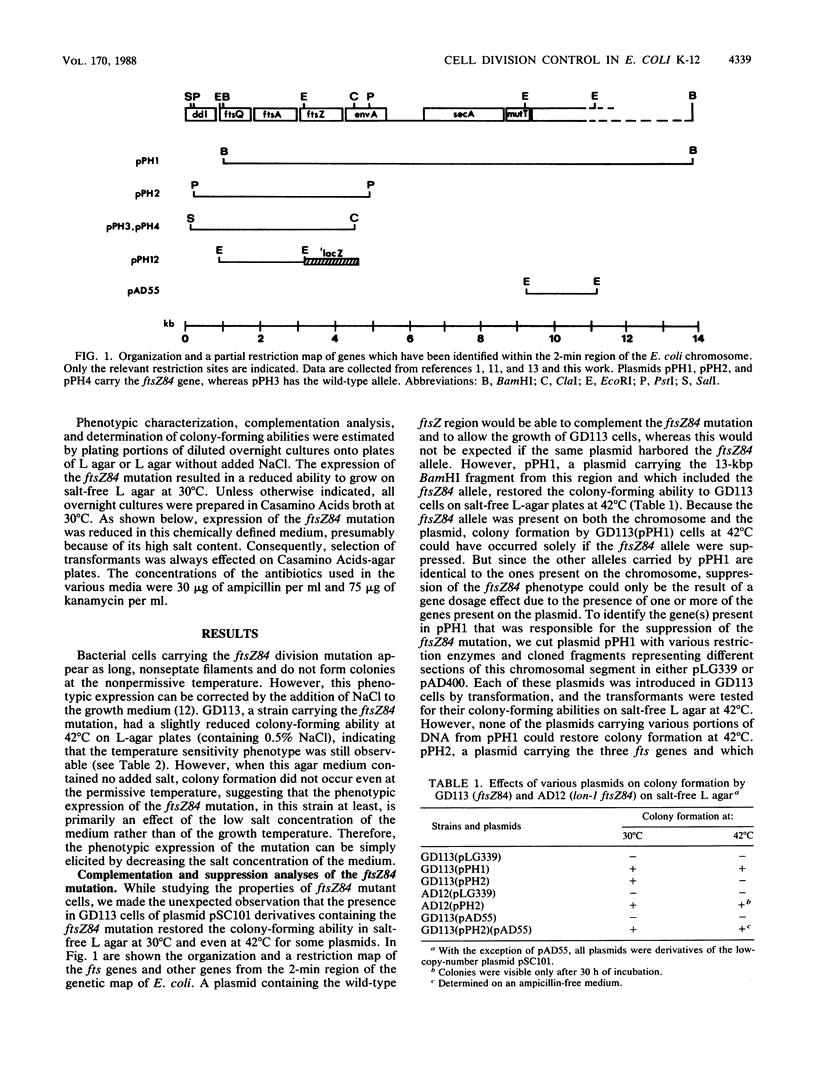
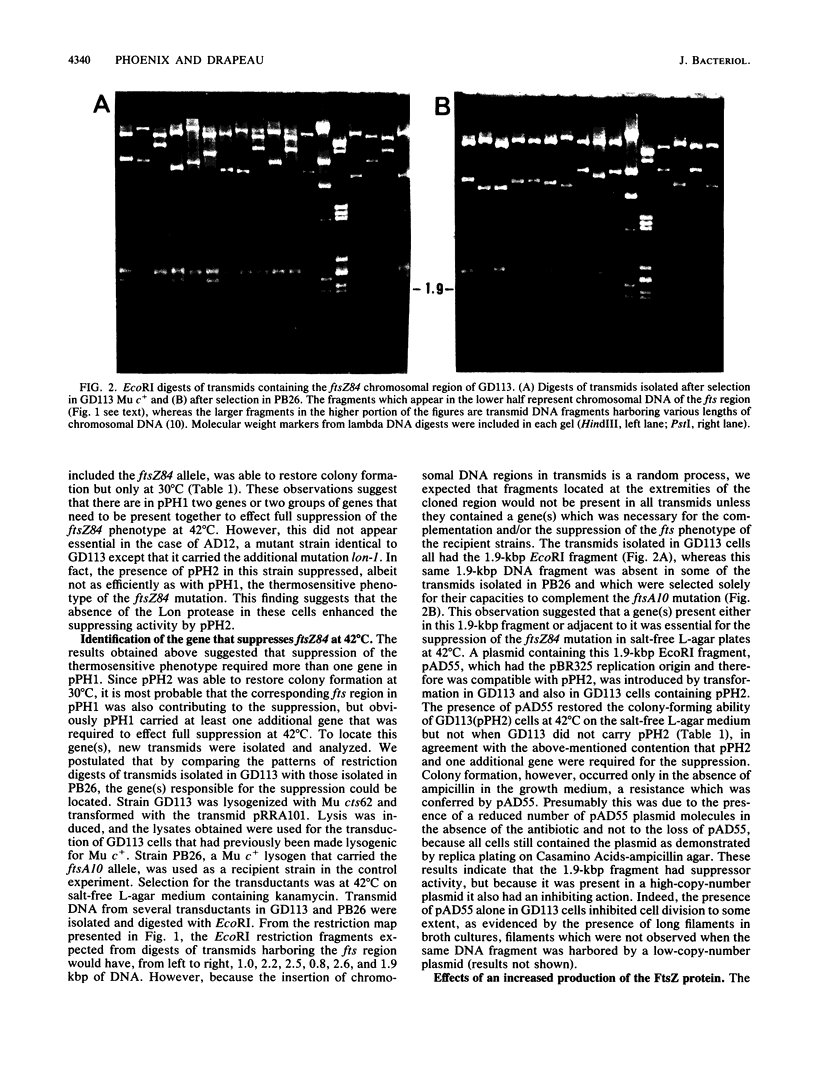
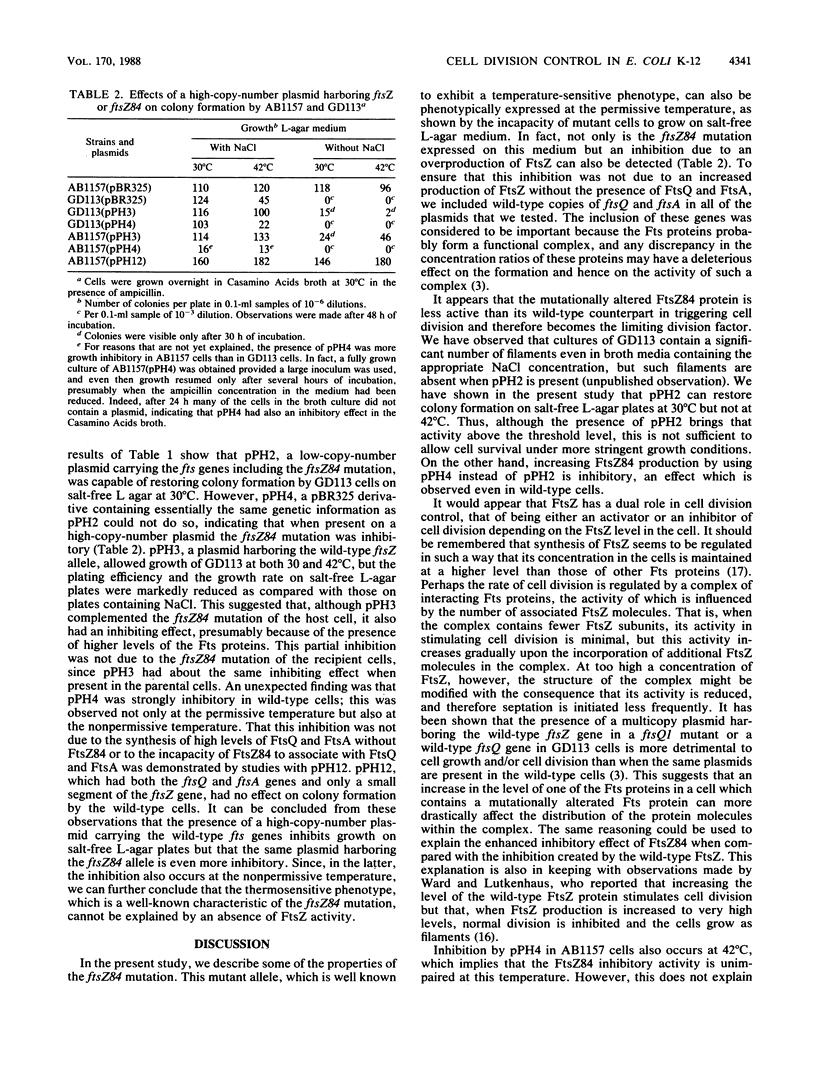
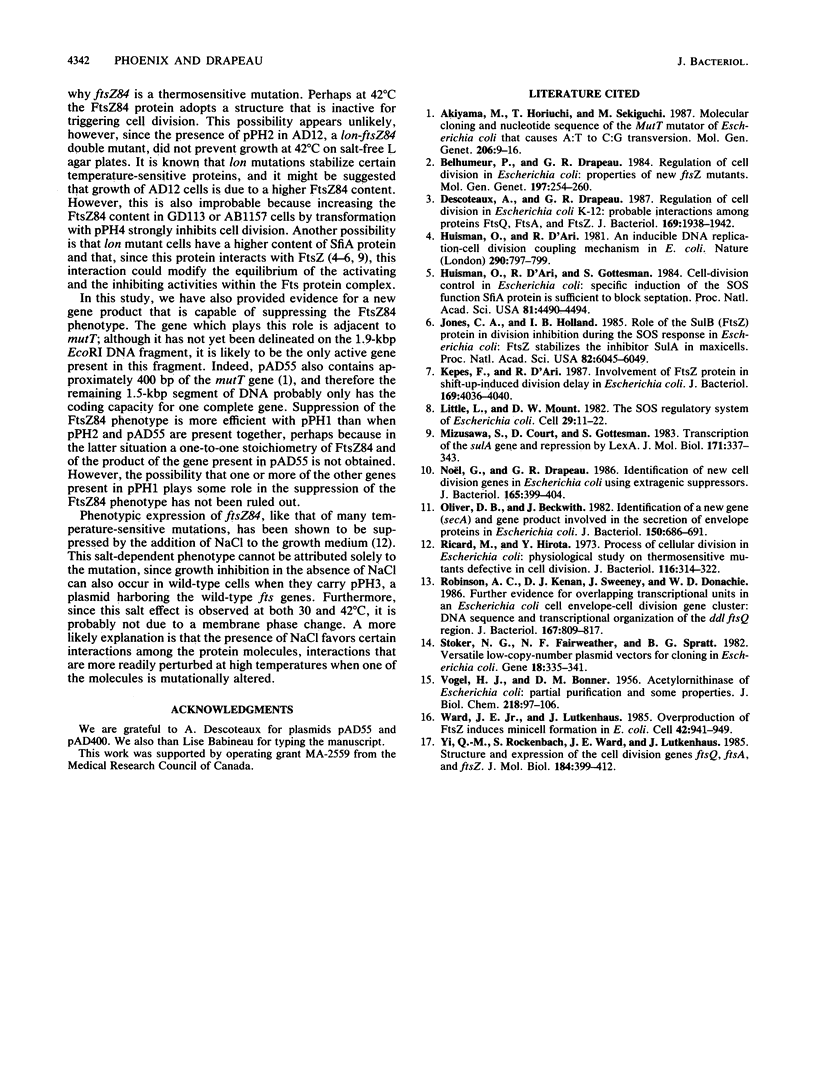
Images in this article
Selected References
These references are in PubMed. This may not be the complete list of references from this article.
- Akiyama M., Horiuchi T., Sekiguchi M. Molecular cloning and nucleotide sequence of the mutT mutator of Escherichia coli that causes A:T to C:G transversion. Mol Gen Genet. 1987 Jan;206(1):9–16. doi: 10.1007/BF00326530. [DOI] [PubMed] [Google Scholar]
- Belhumeur P., Drapeau G. R. Regulation of cell division in Escherichia coli: properties of new ftsZ mutants. Mol Gen Genet. 1984;197(2):254–260. doi: 10.1007/BF00330971. [DOI] [PubMed] [Google Scholar]
- Descoteaux A., Drapeau G. R. Regulation of cell division in Escherichia coli K-12: probable interactions among proteins FtsQ, FtsA, and FtsZ. J Bacteriol. 1987 May;169(5):1938–1942. doi: 10.1128/jb.169.5.1938-1942.1987. [DOI] [PMC free article] [PubMed] [Google Scholar]
- Huisman O., D'Ari R. An inducible DNA replication-cell division coupling mechanism in E. coli. Nature. 1981 Apr 30;290(5809):797–799. doi: 10.1038/290797a0. [DOI] [PubMed] [Google Scholar]
- Huisman O., D'Ari R., Gottesman S. Cell-division control in Escherichia coli: specific induction of the SOS function SfiA protein is sufficient to block septation. Proc Natl Acad Sci U S A. 1984 Jul;81(14):4490–4494. doi: 10.1073/pnas.81.14.4490. [DOI] [PMC free article] [PubMed] [Google Scholar]
- Jones C., Holland I. B. Role of the SulB (FtsZ) protein in division inhibition during the SOS response in Escherichia coli: FtsZ stabilizes the inhibitor SulA in maxicells. Proc Natl Acad Sci U S A. 1985 Sep;82(18):6045–6049. doi: 10.1073/pnas.82.18.6045. [DOI] [PMC free article] [PubMed] [Google Scholar]
- Kepes F., D'Ari R. Involvement of FtsZ protein in shift-up-induced division delay in Escherichia coli. J Bacteriol. 1987 Sep;169(9):4036–4040. doi: 10.1128/jb.169.9.4036-4040.1987. [DOI] [PMC free article] [PubMed] [Google Scholar]
- Little J. W., Mount D. W. The SOS regulatory system of Escherichia coli. Cell. 1982 May;29(1):11–22. doi: 10.1016/0092-8674(82)90085-x. [DOI] [PubMed] [Google Scholar]
- Mizusawa S., Court D., Gottesman S. Transcription of the sulA gene and repression by LexA. J Mol Biol. 1983 Dec 15;171(3):337–343. doi: 10.1016/0022-2836(83)90097-9. [DOI] [PubMed] [Google Scholar]
- Noël G., Drapeau G. R. Identification of new cell division genes in Escherichia coli by using extragenic suppressors. J Bacteriol. 1986 Feb;165(2):399–404. doi: 10.1128/jb.165.2.399-404.1986. [DOI] [PMC free article] [PubMed] [Google Scholar]
- Oliver D. B., Beckwith J. Identification of a new gene (secA) and gene product involved in the secretion of envelope proteins in Escherichia coli. J Bacteriol. 1982 May;150(2):686–691. doi: 10.1128/jb.150.2.686-691.1982. [DOI] [PMC free article] [PubMed] [Google Scholar]
- Ricard M., Hirota Y. Process of cellular division in Escherichia coli: physiological study on thermosensitive mutants defective in cell division. J Bacteriol. 1973 Oct;116(1):314–322. doi: 10.1128/jb.116.1.314-322.1973. [DOI] [PMC free article] [PubMed] [Google Scholar]
- Robinson A. C., Kenan D. J., Sweeney J., Donachie W. D. Further evidence for overlapping transcriptional units in an Escherichia coli cell envelope-cell division gene cluster: DNA sequence and transcriptional organization of the ddl ftsQ region. J Bacteriol. 1986 Sep;167(3):809–817. doi: 10.1128/jb.167.3.809-817.1986. [DOI] [PMC free article] [PubMed] [Google Scholar]
- Stoker N. G., Fairweather N. F., Spratt B. G. Versatile low-copy-number plasmid vectors for cloning in Escherichia coli. Gene. 1982 Jun;18(3):335–341. doi: 10.1016/0378-1119(82)90172-x. [DOI] [PubMed] [Google Scholar]
- VOGEL H. J., BONNER D. M. Acetylornithinase of Escherichia coli: partial purification and some properties. J Biol Chem. 1956 Jan;218(1):97–106. [PubMed] [Google Scholar]
- Ward J. E., Jr, Lutkenhaus J. Overproduction of FtsZ induces minicell formation in E. coli. Cell. 1985 Oct;42(3):941–949. doi: 10.1016/0092-8674(85)90290-9. [DOI] [PubMed] [Google Scholar]
- Yi Q. M., Rockenbach S., Ward J. E., Jr, Lutkenhaus J. Structure and expression of the cell division genes ftsQ, ftsA and ftsZ. J Mol Biol. 1985 Aug 5;184(3):399–412. doi: 10.1016/0022-2836(85)90290-6. [DOI] [PubMed] [Google Scholar]



